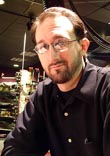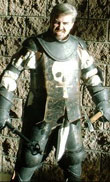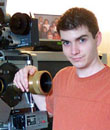|
|
This topic comprises 4 pages: 1 2 3 4
|
|
Author
|
Topic: Nightmare Before Christmas in 3D
|
|
|
|
|
|
|
Brian Michael Weidemann
Expert cat molester

Posts: 944
From: Costa Mesa, CA United States
Registered: Feb 2004
|
 posted 10-02-2006 04:50 AM
posted 10-02-2006 04:50 AM





There we are, right on the list, as usual.
We have a poster and a standee for this, and they clearly say Disney Digital 3D, or Real D, or whatever it is. Or, rather, what I should say is that it clearly DOES NOT say "IMAX" anywhere. Yet, to my dismay, lots and lots of people come through the lobby, see it, read it intently, get excited, and say to their friend "Hey, look, it's in IMAX; we have to see it in IMAX 3D!"
Would it be professional to post a sign next to the posters saying, "Sorry, dumbasses, but 3D doesn't mean IMAX! Do you see IMAX? It doesn't say IMAX!!!"
We're a high profile theatre, and comment cards don't look good if idiot customers complain that we "advertised it in IMAX and it's not in IMAX".
Anyway, I'm not looking forward to this as much as some people. I adore Danny Elfman, and the soundtrack in general, but the film itself never held my interest. And 3D (especially this "fudging" 3D conversion crap) is hardly going to win me over.
| IP: Logged
|
|
|
|
|
|
|
|
|
|
|
|
|
|
|
|
Michael Coate
Phenomenal Film Handler

Posts: 1904
From: Los Angeles, California
Registered: Feb 2001
|
 posted 10-16-2006 08:25 PM
posted 10-16-2006 08:25 PM




A Broadcast Newsroom interview regarding the 3-D conversion.
quote:
A New Dimension for ''Nightmare Before Christmas''
Producer Don Hahn talks about transferring Tim Burton's cult classic to 3D
By Frank Moldstad
Converting Tim Burton's Nightmare Before Christmas from 2D to 3D was a labor of love, as Producer Don Hahn relates in this interview. An Oscar-nominated producer whose works include The Lion King, Beauty and the Beast, Who Framed Roger Rabbit and many other Disney classics, Hahn is a big fan of both Nightmare Before Christmas and 3D movies.
One of the objectives for the 3D conversion was that the original film should not be altered by re-cutting it or adding new scenes. Since the release of Nightmare Before Christmas 13 years ago, it has become a cult classic that is perenially re-released, Hahn notes. The film was written by Burton and directed by Henry Selick, both of whom were extensively consulted during the 3D conversion, which took more than a year of work by a team of people from Industrial Light & Magic and Disney. The film opens in theaters October 20.
The end result is better than anyone hoped for, Hahn says, placing viewers in the midst of the film's animated puppet characters with the aid of green polarized 3D glasses. Here he describes the 3D transfer process and talks about the promise of a new generation of digital 3D technology.
How does the look of Nightmare Before Christmas 3D differ from what people are familiar with from old 1950s sci-fi movies?
Well, it's quite different actually. There were some great 3D movies back in that era, and 3D goes back even to the 20s. But this is special on a couple of levels. It's digital 3D, which certainly you've seen -- Chicken Little was the first digital Disney 3D movie out there. The frame rate and the quality of the 3D is pretty astounding. And secondly, this is the first film in motion picture history that's been created from an original classic movie. So it's a chance to take a movie that's 13 years old now, and through a lot of digital magic tricks, with help from ILM, we've been able to turn it into this wonderful digital movie. So it's a first on a couple of levels -- the digital cinema aspect, and the fact that it's the first movie that's been turned into a 3D movie.
What's involved in the transfer process of a 2D movie to 3D, and how complicated is it?
It's really complicated. In the case of Nightmare, you take the original movie and scan it into a computer. That gets cleaned up and restored, and then it becomes your left eye. So when you look at the movie, if you want to see the original version, you just look with your left eye. But then we have to create a whole right eye version that's three inches over, so you can get the dimension of 3D. And that's done by rebuilding the whole movie as a digital picture. In other words, if you have a shot of Jack Skellington, you have to build Jack, and you have to build the background behind him, his house and the snow, or whatever is behind him in a digital world. And then we project a movie on to that digital geometry and then move the digital camera over to the right and rephotograph that for the right eye version.
That's a lot of work.
Yeah, it's really complex, and oddly it's as simple as the Madame Leota effect in the Haunted Mansion, where they project onto a featureless mannequin. That's the really simple version that I can understand. And that's literally how it works, but it's obviously far more complicated than that because it involves really making it pristine and an exact replica of the movie on the screen.
These days you would just shoot the movie in 3D using a second camera, right?
Yeah, if you are shooting a movie like that today, you would use two cameras side-by-side, which is what was done in those old 50s movies. Now, of course, you would shoot with two digital cameras side-by-side and you would have this wonderful pristine 3D movie. And people are starting to do that. Henry Selick [Nightmare, James and the Giant Peach] is working on a movie that won't be done for a couple of years, but he's starting to think about shooting in 3D.
It seems like more theaters are adding digital projectors for screening 3D films, too.
Yeah that's the other thing, as digital cinema has become more and more prevalent and available, you need a special screen and a special projector to do this. Our exhibitors have been fantastic. We had 80 screens for Chicken Little and probably close to 200 on this movie that are the state-of-the-art in digital projection. And that's part of what makes the experience so wonderful, because in the 50s you had to wear one red glass and one blue glass, and you got a headache. And now you wear glasses, but they are very lightweight effortless things. And the frame rate is so high -- as opposed to 24 frames per second, you are getting probably five times that. You don't get the flicker and you don't get a headache.
That's what I associate with the old ones.
Yeah, I know, we all do. I watched Dial M for Murder last night, the Hitchcock 3D movie. We projected it here at the studio. And boy, it really hurts after a while. It's a a great movie, though.
Yes it is! But this 3D process is more believable because it has a more realistic depth of field, right?
Yeah, I mean the thing about a stop-motion movie like Nightmare is you really feel like you're in there with the puppets. And you see things that you've never seen before. When we started working with Tim Burton on this -- we wanted to include the original filmmakers at every step of the way, because it's their movie -- we wanted to make sure that he liked what we were doing. And he was amazed that you could really feel like you were standing there in the same space as the puppets are.
I suppose he saw things that he would have done differently had he been creating it for 3D.
Yeah, that's the truth with any movie when you revisit it after a while. But I think this is a real treat for everybody to revisit the movie and be able to see it through two eyes instead of one.
Will this process be transferable to home video on DVD?
It's not today, but the technology is close. Although I think that the great thing about Nightmare is that it's a perennial, it comes out every year. People love it, and it's turned into this cult movie. But the technology for home theaters is catching up, because people are working on it with Blu-ray discs and things that hold more. So we'll probably get to the point where you can actually enjoy 3D movies in your home pretty soon.
You mentioned Chicken Little, which was released in both 2D and 3D. Did moviegoers show a preference?
I don't have any facts or figures off the top of my head, but the 3D experience is terrific because it's more immersive. So the theaters that were showing Chicken Little in 3D were really successful. That's why we continue to do it, and in fact next year, when our next movie Meet the Robinsons comes out, it will be in 3D as well.
Is the 3D experience better with animation than with live-action?
Well, I don't know if I would make that argument. In essence, Nightmare Before Christmas is a live-action movie. It's animation, stop motion animation. But it had sets that were built, and lights, and instead of actors we had puppets. But it was very much shot in a live action way. I think they both can be great. James Cameron has done some amazing 3D IMAX movies that were live action, and I think they are breathtaking. So I think with the right filmmaker, they can both be great.
Do you think the market for 3D films is going to grow quickly over the next few years?
I hope it does, because I'm a fan. Open Season from Sony has just come out, and they have a 3D release. There is a little 20-minute segment of Superman that was in 3D. I think it's an experience that theatergoers can enjoy, one that makes it special to go to the movies, not unlike it was in the 50s when you got a chance to go see 3D movies.
Somebody should take a photo like the great one Life magazine had in the 50s, with the entire audience wearing 3D glasses.
I know! I think that the one-sheet for Nightmare Before Christmas 3D is a little bit like that, with the characters wearing their glasses.
Are there any differences with the way the sound is mixed for a 3D movie, or remixed in this case?
Yeah, in the interests of making the best possible version of the movie, we went back to Terry Porter, who was the sound mixer on the original movie. He did a remix of the film with 3D in mind, so that the sound envelopes you, because when you watch the movie you're really in the movie. We felt that the sound should be immersive also. So he restored and remixed the movie to be appropriate for 3D.
I guess he would mix differently in response to characters that were deeper into the field.
Yeah, and you can make small adjustments to that. And the other thing we did was that we brought the music out into the house a little bit more. Instead of the music being on the screen, you feel like it's coming out at you from the surround speakers a little bit more. So you're in the middle of the orchestra and the music as well.
When is the premiere?
There's a premiere I believe on October 16 in Hollywood, a black carpet premiere, which is appropriate. And then everywhere October 20.
How long has this taken you?
Oh boy, we started talking about it a year ago, and doing some tests with our friends at ILM, who are amazing. I can't say enough about them. Really, they are the ones who have found some amazing technical approaches to the problems of doing this. We just finished our last shot yesterday. as a matter of fact. And it's taken about a year and a real concentrated three or four months here to finish the movie.
Is editing the movie equally difficult?
It's not, because one of the things that we all agreed we started out is that it's a classic film by this time. And if not a classic, you can at least agree that it's a cult film, because it has a huge following internationally as well as domestically. In Japan, it is absolutely huge. So we decided that we really didn't want to touch the original, we didn't want to add to it, or add sequences we hadn't seen. We didn't even clean up some of the mistakes. If there was a camera bump or a light bulb went off on the original movie, we left it, because we felt that was part of the its charm.
It's an affectionate approach, right?
It is, it absolutely is. We didn't want to mess with the original. So editing it was, I won't say a breeze, but really more of a labor of love. It was really about restoring it, we didn't change a frame of the original.
Internationally, is there a good population of theaters with digital 3D projectors and screens?
Not as much as here, but it's growing fast. This movie will be released certainly in Japan and in Europe, particularly in London and Tokyo. It might be two or three or four screens, as opposed to more. But that's really what 3D is, since it does require special equipment, you find these will be probably in the best venues in those cities. So if you go to the best multiplexes or local theaters you'll be able to see this.
And it will probably have long runs in the theaters where it plays.
Yeah, that's the idea. The cool thing about the story is that it's a Halloween movie but it's also a Christmas movie, so you can get out and enjoy it for a while.
Well congratulations, it sounds like a lot of fun.
Thanks! I hope you enjoy it when you see it. It's pretty cool, I have to admit. We went into it very cautiously, wanting to make sure it was really great, and kind of celebrated the original movie. And it came out a lot better than any of us had hoped for.
| IP: Logged
|
|
|
|
Frank Angel
Film God

Posts: 5305
From: Brooklyn NY USA
Registered: Dec 1999
|
 posted 10-18-2006 10:36 AM
posted 10-18-2006 10:36 AM





quote:
The end result is better than anyone hoped for, Hahn says, placing viewers in the midst of the film's animated puppet characters with the aid of green polarized 3D glasses
Green polarized glasses? What's he talking about?
quote:
this is the first film in motion picture history that's been created from an original classic movie. So it's a chance to take a movie that's 13 years old now, and through a lot of digital magic tricks, with help from ILM, we've been able to turn it into this wonderful digital movie.
Oooh...gotta love those DIGITAL magic tricks. But not to nit-pick, for a car to qualify as a "classic," at least here in NY, it has to be at least 25yrs old. But then again, Disney's not one to quibble -- they call ANY re-release of theirs a "classic," so I guess Hahn can't be faulted. But I can ask, does he think it a "wonderful digital movie" because it was a wonderful movie first or because now it's a wonderful DIGITAL movie. Plus, I love the fact he thinks this film is "a first on a couple of levels -- the digital cinema aspect, and the fact that it's the first movie that's been turned into a 3D movie." Hmmmm..... 1) it's DIGITAL, wow....that's gotta be a first, and 2) it's been turned into 3D....phony, never-intended-to-be-seen 3D. Seems to me, all those arguments about why it was wrong to colorize classic films that were never conceived in color apply equally to films never conceived to be 3D....but that's all about aesthetics and when there's money to be made, well....on to 3Dization!
And someone must have told him that film isn't pristine, only digital is pristine: "it involves really making it pristine and an exact replica of the movie on the screen.....Now, of course, you would shoot with two DIGITAL cameras side-by-side and you would have this wonderful pristine 3D movie."
One has to wonder about Mr. Hahn's technical grasp of what is actually going on when you hear him say " in digital projection. And that's part of what makes the experience so wonderful, because in the 50s you had to wear one red glass and one blue glass, and you got a headache. And now you wear glasses, but they are very lightweight effortless things." It's pretty scary to me that this guy is making a 3D movie and has that misconception about the process which was used for the 3D films of the 50s, confusing the anaglyphic and polaroid processes, a misconception that even those who have a passing knowledge about 3D history know to be patently incorrect.
And how much more lightweight can these new "green" polarized glasses be than the cardboard or plastic polarized glasses of the 50s?
Then he says this, which really shows a prejudice that comes from a lack of knowledge "And the frame rate is so high -- as opposed to 24 frames per second, you are getting probably five times that" probably? can we be just a tad more accurate is five times? maybe four? what?!
"... you don't get the flicker and you don't get a headache.....I watched Dial M for Murder....projected it here at the studio. And boy, it really hurts after a while.
Well, if the guys setting up that presentation knew as much as Mr. Hahn about the original dual projection 3D, it's no wonder he got a headache. Evidently he wasn't at the Egyptian Theatre in September for the 2nd 3D Expo where they actually knew what they were doing and showed DIAL M correctly, as well as all the rest of the original 50s titles and no one got headaches, even after watching triple bills. And by-the-way, flicker is not an issue with 24fps, either 3D or 2D -- that's the frame rate at which we watch movies all the freakin time.
Sorry for the nit-picking, but I just hate it when people with less than a complete grasp of it feel they've got to piss on everything that's gone before them in order to make their project seem important. No respect for the past.
Oh and that whole section on remixing the sound to "match the 3D," like a lot of this interview, sounds like just a lot of bs. Just like the explanation of how they rendered the 3D...does anyone have a better picture now of how this is done after reading this guy's gibberish? Oh sorry, my stupid -- you move the camera over two inches -- now I get it. But wait -- when the image has been scanned into the computer, there is no effin digital camera.
OK, I'm done now.
| IP: Logged
|
|
|
|
|
|
All times are Central (GMT -6:00)
|
This topic comprises 4 pages: 1 2 3 4
|
Powered by Infopop Corporation
UBB.classicTM
6.3.1.2
The Film-Tech Forums are designed for various members related to the cinema industry to express their opinions, viewpoints and testimonials on various products, services and events based upon speculation, personal knowledge and factual information through use, therefore all views represented here allow no liability upon the publishers of this web site and the owners of said views assume no liability for any ill will resulting from these postings. The posts made here are for educational as well as entertainment purposes and as such anyone viewing this portion of the website must accept these views as statements of the author of that opinion
and agrees to release the authors from any and all liability.
|

 Home
Home
 Products
Products
 Store
Store
 Forum
Forum
 Warehouse
Warehouse
 Contact Us
Contact Us




 Printer-friendly view of this topic
Printer-friendly view of this topic







![[Smile]](smile.gif) , here are the cities these locations are near.
, here are the cities these locations are near.



![[Wink]](wink.gif) ).
).



![[puke]](graemlins/puke.gif)

![[evil]](graemlins/evil.gif)



